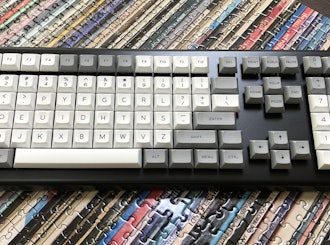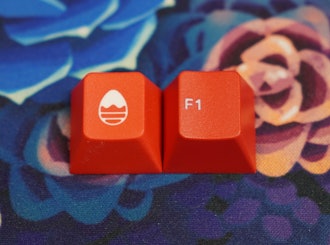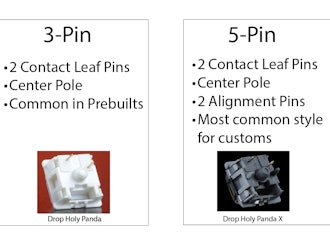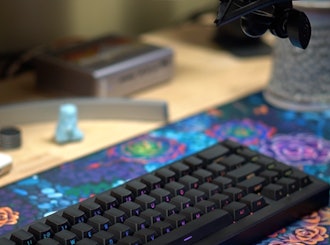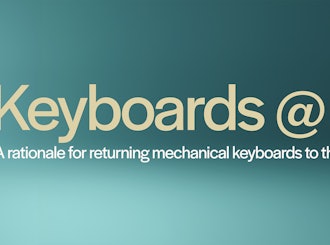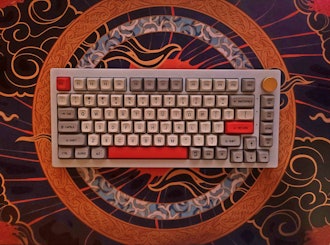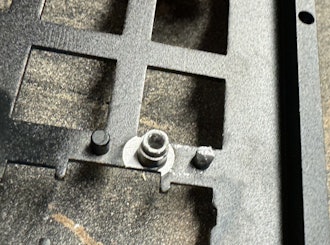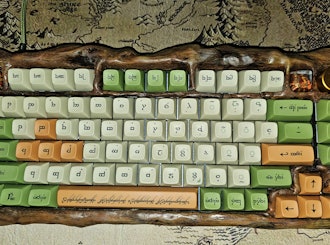Click to view our Accessibility Statement or contact us with accessibility-related questions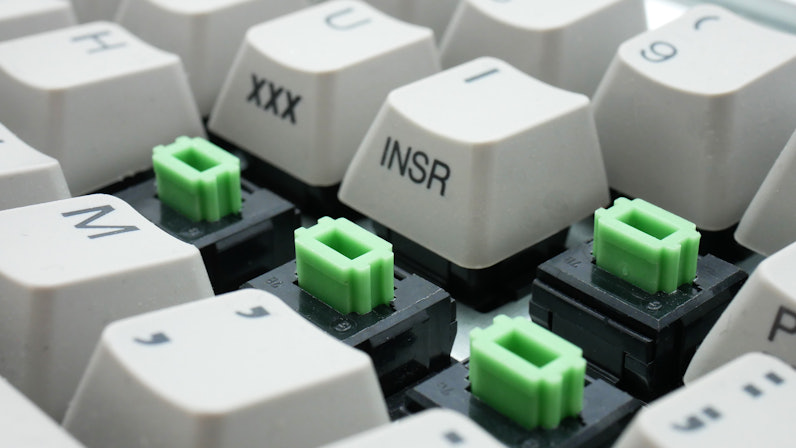
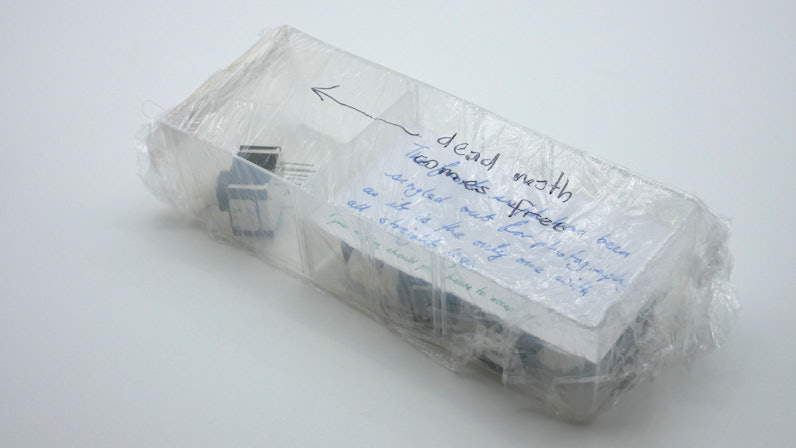
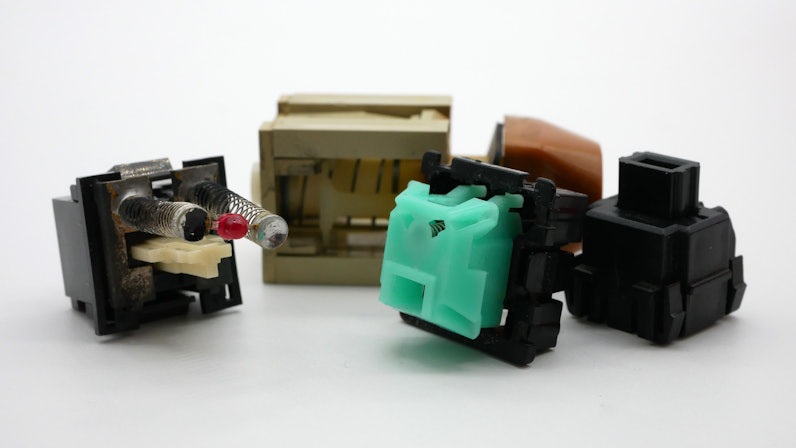
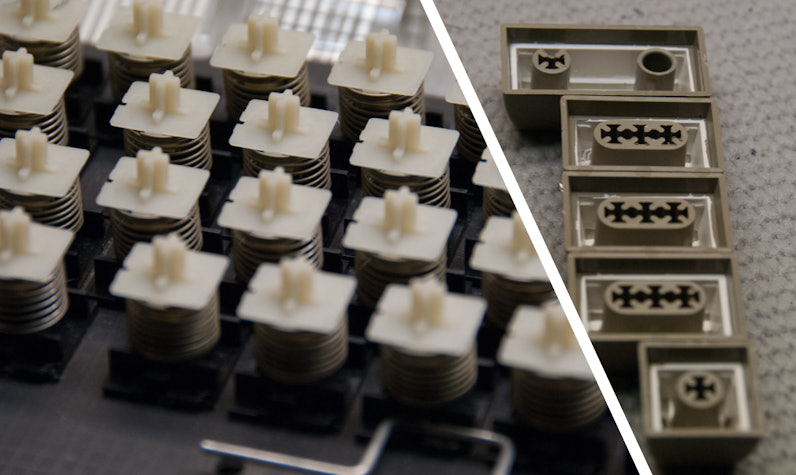


















The Vintage Switch Conundrum

Figure 1: What could be so confusing about some pretty NOS Alps SKCL Greens?
Having thoroughly beaten my opinions to death on well over a hundred different modern, MX-style switches over the past few years, one of the most common questions I get revolves around why I hardly use and/or review vintage, non-MX style switches at all. After all, the wide world of vintage mechanical keyboard switches is full of unique, odd mechanisms and “all modern switches are just recolors of each other.” While I take personal issue with that incredibly misguided second claim, I can totally understand how people can look at the wide swathes of variation in vintage switches and naturally think that that would be something I’d gravitate towards. And for what it’s worth, vintage switches are both incredibly interesting and something that I have quite a lot of hiding away in boxes. Some of my favorite brands and styles include RAFI Hall Effect switches, Hi-Tek 725s of all forms, SMK Inverse Cross Mount switches, and probably a few dozen more I don’t have time to mention in passing. However, just liking certain types of switches and having a good few of them lying around in my personal collection is far from what it takes for me to write out a full review of them. In fact, I think that using and reviewing vintage switches is quite a bit more difficult than most people would initially think. In case you don’t believe me, have you considered…
Condition
Figure 2: I'm not joking - this came in a vintage lot of switches that I received...
Perhaps the single biggest issue that plagues the buying, collecting, and especially reviewing of vintage switches is the condition that you can find them in. You very rarely think about the conditions of your modern switches when you are buying them second hand or reading a review of them from your favorite switch reviewer because of the fact that they were mostly likely produced within the last handful of months and stored in well kept, factory sealed baggies the entire time. Vintage switches, though, do not share this same luxury. With switches very rarely being sold loose and only ever being built into fully usable keyboards multiple decades ago, most vintage switches are rescued in dusty, dirty, or downright damaged fashion from sources that have agglomerated them together after untold numbers of years of use and abuse. Attempting to ascribe any sort of good baseline metrics about a vintage switch’s performance is thus rather hard to do because the dirty trashcan you fished yours out of might be different than the dusty closet someone else found their switches in, and who knows what happened to those boards or switches before that point in time. In order to either try and account for this in your switch review or to try and make your own vintage-switched keyboard with more or less consistent feelings across all of your keys, you would have to go through immense amounts of time, testing, and money to source many different batches of any given switch to find a truly representative spread. Speaking of effort put in, have you also considered….
Availability
Figure 3: Good luck finding any of these just lying around these days.
Availability, or lack thereof, permeates the vintage switch and keyboard scene from top to bottom and very few people stop to consider it until they are already in too deeply themselves. Remember that dusty closet or trashcan referenced above? Yeah, those are not nearly as common as you may hope if you’re trying to find a particular subset of vintage switches. Tack on the fact that simply buying loose vintage switches on the aftermarket is rarely an option, and you’re effectively stuck having to find a full keyboard of them and then going through the heartbreaking process of breaking down the keyboard for its parts if you only want the switches to put in a custom build of your own. Oh, wait - outside of Alps and a rare few niche instances, cases and PCBs that are compatible with vintage switches are incredibly rare too. So assuming you can find a modern case, a PCB, and all switches with more or less the same condition that you can harvest to use, the chances are that there are layout mismatches between vintage and modern keyboards that will throw yet another wrench into your situation. Disregard differences between where certain keys are - this point is squarely to be made about the switches themselves. Vintage keyboards are rife with switch oddities such as spacebars with different weights, dummy switches without springs, random variations in colors, weights, and offerings between opposite ends of the boards, and so many different setups that it’s a real possibility that even if you found a full keyboard to harvest, they might not have enough of the switches that you want to use or review! And yet, if you manage to fend off all of those difficulties, you’re still fighting an uphill battle with….
Keycaps
Figure 4: Yes, keycaps as odd as these came with switches as seemingly normal as those. Oak Switch Systems Full Travel Membrane keyboard from user pyrelink on DeskThority.
As is probably super evident to anyone who has peered into the depths of vintage keyboards before, vintage switches come with such a wide range of keycap mounts that they more or less look like alien crop circles compared to traditional MX mounts. Even if you’re working in the most ideal of circumstances and you found a mostly okay set of switches on a mostly okay board that you are going to be able to port into a mostly okay modern case or you intend to use as is, there’s still a good chance the dusty closet/trashcan/EBay listing you’re rescuing these parts from will consume one of your keycaps along the way. That’s right - a single or a few missing keycaps on vintage keyboards is a lot more common than you would think. While it may be the bane of their existence, and significantly raise their blood pressure in doing so, find a vintage keyboard collector you know and ask them if they have any missing keycaps on their boards they’ve rescued. (Just try it once, trust me.) And while this seems like the least of the issues raised thus far about using and reviewing vintage switches, keycaps also suffer from the same condition and availability issues that plague vintage switches above, as well…
So in the event that you were one of the people who have ever asked me this question before, you now more or less understand why diving into vintage keyboard switches is so complicated. Don’t get me wrong here - I absolutely love them and rather enjoy the few keyboards that I have that are built with vintage switches, though they are far from perfect examples I’d want to share with the world. Furthermore, sourcing down multiple iterations of these boards to try and get a perfect review set is even more money than I care to spend on switches in some instances. As well, please don’t let this discourage any interests you may have about vintage switches. I simply wanted to share this article just to make you all aware of some of the more glossed-over difficulties of getting into and using vintage switches that most people don’t talk about. Want to learn some other secrets that people don’t tell you about switches, consider checking out my article ‘Switch Marketing Terms: What to Know and What to Ignore’.
(Edited)

search
close
Sort by: Newest
keyboard_arrow_down
Andy_Who
359
Keyboard Club Member
Feb 29, 2024
Would you recommend any videos or guides or vendors for jumping into vintage switches? Not even vintage just keyboards using non-mx or non-topre switches?
When i got into keyboards i heard about alps. still have never used a board with them.

imaher
76
Apr 3, 2024
Andy_WhoI’m happy to recommend Chyrosran22
on YouTube. Alps are the best sounding switching of all time.
https://youtube.com/@Chyrosran22?si=8GrnzCdty177Jxkh
Clique
15
Apr 4, 2024
imaherLove the Alps. I believe Matias boards with white Alps switches are still being produced out of Canada. The switches are soldered in, of course, so when a switch fails, a board has to be opened that isn't meant to be opened etc. etc. etc. I had a couple such boards as my daily drivers and they didn't hold up well. They were too expensive to replace every year so I was forced to leave them behind.
2-bit_Joe
12
Feb 28, 2024
As an Alps enthusiast, I almost feel vindicated. Does Drop prefer you to write about things they can offer for sale? There are at least a few contemporary Alps influenced products they could conceivably offer.
ThereminGoatMK
400
Keyboard Club Member
Feb 28, 2024
2-bit_JoeDrop hasn't asked me to really write about anything in particular, though it was assumed by both them and I that switches, as broad of a subject as that is, would likely be where I would focus my time. The reason I've largely focused on modern switches and topics related to MX-style switches is for much the same reason I focus on similar stuff on my own website - it's just what I am the most well versed in and have the most experience with. I'm sure if I wanted to drop an ode to artisan keycaps or an article aabout my particular favorite makers next week they wouldn't have an issue with that at all.
I also have done an article on here about keyboard meetups at large and their importance too, in the event that that did not convince you enough!
Related Posts

dvorcol
Support for Alternative Layouts
This is a summary of how alternative layouts have been supported by kits such as Colevrak and Homing. It is not a discussion of alt layout performance and development, but if that interests you I highly recommend starting with Pascal Getreuer’s A guide to alt keyboard layouts (why, how, which one?). It’s a concise and comprehensive overview with links to some great sites that go deeper. He also has a separate Links about keyboards page. The Keyboard layouts doc he recommends explains layout goals and metrics in detail, summarizing the alt layouts discussed here as well as more than one hundred others. Sculpted-profile The majority of custom keycap sets are sculpted-profile (Cherry, SA, MT3, KAT, etc. - more on profiles generally here) so let’s start there. Because each row has a unique keycap shape, alt layouts require a unique keycap for each legend that moves off its QWERTY row. At first there were two The Dvorak layout was patented in 1936 by August Dvorak & William L....
Apr 23, 2024
ThereminGoatMK
Do I Need to Lube My Keyboard Switches?
Figure 1: Sometime around here is a good time to ask that question... If you’re new to the mechanical keyboard hobby, I have no doubt that planning your first keyboard build is a bit of a daunting task. To be entirely honest with you, it’s only a tiny bit less daunting for your second or even third keyboard builds should you stay around a little while longer. You’ve got the keyboard itself to worry about, stabilizers, keycaps, and even switches on top of all of the intangible marks you want your dream keyboard to hit. Switches are especially daunting right out of the gate as there’s just so many options out there to pick from – each with their own unique specifications, manufacturers, and more. Yet, in spite of all of these differences between switches, time and time again I find people always asking about lubing switches as one of their chief concerns when it comes to picking some up. With countless numbers of content creators talking about lubing switches, its no...
Apr 17, 2024

HoffmanMyster
DCX vs DCD vs DCL - Drop’s Keycap Profiles Explained
We’ve covered the basics of keycap profiles before—spherical/cylindrical, sculpted/uniform, etc. One thing that has come up more and more over the years as we’ve expanded our portfolio of offerings here at Drop is the distinction between some of our similar profiles. Specifically, what is the actual difference between DCX, DCD, and DCL? Cylindrical Profiles To recap the previous article on the topic, one of the most basic ways to separate various keycap profiles is by shape (cylindrical, spherical, or flat). DCX, DCD, and DCL are all cylindrical profiles. The most famous cylindrical profile is Cherry profile, as defined by the original manufacturer of the keycaps—Cherry. GMK now owns those tools, and as such, only they can technically claim to produce “Cherry” profile keycaps. Similar keycap profiles are often called Cherry profile colloquially, but are in actuality slightly different. For the sake of not splitting hairs, all of the cylindrical profiles discussed here are...
Apr 9, 2024
cobertt
3 or 5? How many pins does your switch really need?
One of the oldest questions, albeit one you don’t see very often anymore, is about 3-pin and 5-pin MX switches. Early in the custom switch scene, budding enthusiasts would need to determine whether their keyboard needs 3-pin or 5-pin switches. Today, the question doesn’t appear as often as it used to, but it is still important to know the difference and when one is a better choice. The difference between these two types of switches is in the name, the number of pins. As seen in the pictures below, 3-pin switches have two metal legs for the contact leaves and registering of switch presses as well as the stem pole. These switches were traditionally called plate mount switches, as they relied on the plate to align the switches on the PCB. 5-pin switches have the same contact pins and stem pole but are also accompanied by two additional alignment pins on the left and right of the stem pole. These were called PCB mount switches, as they could be used without plates as the PCBs would...
Apr 2, 2024
ThereminGoatMK
Mechanical Keyboard Sound Isn't That Simple
Figure 1: I couldn't think of a more literal way to represent this article if I tried... Looking back just a few years ago, there’s no doubt that the huge influx of people that joined the hobby at the peak of the COVID pandemic were drawn to keyboards by way of YouTube, TikTok, and other audio-visual content platforms. Even as the output from these content creators has waned in recent months, their collective impact and legacy on the keyboard hobby is rather firmly etched in the history books. As a result of all of their sound tests, build logs, and opinion videos, the message is clear to any new person joining the hobby: mechanical keyboards are all about the sound. Thock this, clack that. Whether it’s keyboards, keycaps, or even singular switches, seemingly everyone new to the hobby meticulously pores over each component of their keyboard not in an attempt to figure out how it will feel in hand, but how it will sound as they’re furiously grinding their way out from...
Mar 27, 2024

storyboardtech
Keyboards at work: A rationale for returning mechanical keyboards to the office environment.
As I walk down the hall to my office each morning, I hear the discordant clattering of keys coming from my coworker’s office. In the hall… several doors down… I hear them. Like the loose teeth in my grandma’s poodle, barely hanging on, they rattle and heave. If anyone’s ever told you that mechanical keyboards are too loud, it’s simply because that person has become completely desensitized to the garbage-bomb that is the standard office computer keyboard. In the 1980’s and 90’s, it was common to hear the sound of unmitigated excellence when you walked into an office building. The rapid gunfire-like precision of a room full of high-quality computer keyboards firing in unison. Even in the early 2000’s when I worked in a south-side Chicago newspaper newsroom, it was still filled with such keyboards. Ten to fifteen years into their professional daily use, they were still magnificent in sound and feel. Punctual, clean, decisive. In those days, professional keyboards didn’t come...
Mar 21, 2024
Trending Posts in Mechanical Keyboards

DaveKaretnyk
Mode Tempo with Red Samurai
Mode Tempo (60%) with GMK Red Samurai & Mode Lotus keycaps
Apr 25, 2024

dvorcol
Support for Alternative Layouts
This is a summary of how alternative layouts have been supported by kits such as Colevrak and Homing. It is not a discussion of alt layout performance and development, but if that interests you I highly recommend starting with Pascal Getreuer’s A guide to alt keyboard layouts (why, how, which one?). It’s a concise and comprehensive overview with links to some great sites that go deeper. He also has a separate Links about keyboards page. The Keyboard layouts doc he recommends explains layout goals and metrics in detail, summarizing the alt layouts discussed here as well as more than one hundred others. Sculpted-profile The majority of custom keycap sets are sculpted-profile (Cherry, SA, MT3, KAT, etc. - more on profiles generally here) so let’s start there. Because each row has a unique keycap shape, alt layouts require a unique keycap for each legend that moves off its QWERTY row. At first there were two The Dvorak layout was patented in 1936 by August Dvorak & William L....
Apr 23, 2024

CousinTimmy
Promo codes for stack Macropad v2
is there any promo codes right now that work with the STACK OVERFLOW THE KEY V2 MACROPAD? link:https://drop.com/buy/stack-overflow-the-key-v2-macropad?searchId=ead314359856d5486d35f4713cff32e9
Apr 23, 2024

Robbedoes
*Help* Screw in stabilizers not fitting in Dropshift V2 keyboard
I'm trying to build a mechanical keyboard with screw in stabilizers, I've build some mechanical keyboards with click-in stabilizers, never with screw in. Somehow one of the pins of the metal top-part collides with the screw in stabilizer of the numpad "enter key". I already tried grinding of a bit of the pin that collides with the stabilizer, but unfortunately I can't make it fit/close properly. You can see that the pin of the toppart leaves a mark on the bottompart of the stabilizer, see picture 2. What am I missing? Using Durock V2 in a Dropshift fullsize V2. See pictures below, thanks in advance!
Apr 23, 2024
Fukyachickennuggets
Polymer clay
Don't drop crazy cash on custom wood builds! Instead go buy polymer clay and paint. Then you can spend a ridiculous amount of time trying to make it look like you can afford to drop crazy cash on...
Apr 22, 2024
GrEEdYY
HELP PLEASE!
HELP PLEASE! I put noise insulation in the keyboard and after that it stopped working, the only sign of life is 5 blinks of orange light.can do something about it? model:DROP ALTv1
Apr 22, 2024
